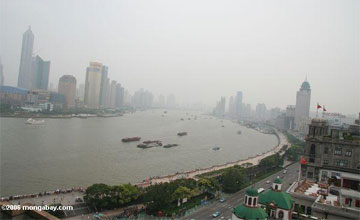China may surpass U.S. in carbon dioxide emissions by 2009
China may surpass U.S. in carbon dioxide emissions by 2009
mongabay.com
November 7, 2006
China’s output of carbon dioxide, a gas linked to global warming, may surpass that of the United States by 2009, about a decade earlier than previous estimates according to a report released Tuesday by the International Energy Agency.
China currently ranks second behind the United States in carbon dioxide emissions, but rapid economic growth, fueled heavily by coal, is spurring a dramatic rise in greenhouse gas pollution. China’s emissions growth is one of the big reasons why the United States and Australia have refused to sign the Kyoto Protocol which calls for emissions limits for industrialized countries but none for developing economies including China, India, and Brazil.
The new International Energy Agency report says that global energy demand is projected to grow 53 percent by 2030, with demand for coal jumping 59 percent. Overall carbon dioxide emissions are expected to climb 55 percent to 44.1 billion tons in 2030.
|
|
RELATED ARTICLES
China moves as environmental problems mount. China, the world’s most populous country and fastest growing economy, faces a host of environmental problems. Energy and water shortages, water and air pollution, cropland and biodiversity losses, and escalating emissions of greenhouses gases are all concerns as the country moves towards world superpower status. While these issues could threaten to destabilize the country and derail economic growth, it appears that it is taking steps to address some of these challenges.
China and India show rapid increase in global warming emissions. Greenhouse gases on the rise, China and India show rapid increase; Rich countries consume more than half the energy produced in the globe; Poor countries still depending on traditional fuels
Coal to oil conversion gaining interest in China, U.S.. High oil prices are spawning greater interest in technologies that convert coal into liquid fuel, according to an article published yesterday in The Wall Street Journal, but the shift could have a significant impact on the environment. Heightened tensions in the Middle East combined with booming demand and political instability in other regions have put a premium on crude oil and forced China and the United States — the world’s largest energy gluttons — to look towards secure sources of fuel. Both countries are coal-rich but petroleum-poor.
US “exporting” carbon emissions to China. The growth of Chinese imports in the U.S. economy boosted the total emissions of carbon dioxide (a primary greenhouse gas) from the two countries by over 700 million metric tons between 1997 and 2003, according to a study published online in the journal Energy Policy. The analysis, prepared by two scientists at the National Center for Atmospheric Research, suggests that American emissions of carbon dioxide in 2003 would have been 6% higher if the United States had manufactured the products that it imported from China. Meanwhile, China’s 2003 emissions would have been 14% lower had it not produced goods for the United States.
Solar Energy Powers Mainland China’s Richest Man. The largest private fortune in mainland China may belong to Shi Zhengrong, the founder of the China’s largest producer of photovoltaic equipment used to convert sunlight into electricity, according to an article in today’s edition of The Wall Street Journal.
